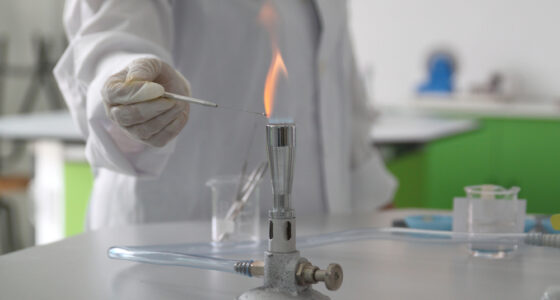Asbestos protects against heat and flame, resists electricity, and resists chemical degradation, making it a valuable component in research laboratories. As a result of asbestos being a component of several types of laboratory equipment, laboratory technicians, researchers, and clinical scientists were put at risk of being diagnosed with malignant mesothelioma and other asbestos-related diseases.

How Was Asbestos Used in the Laboratory?
For centuries, asbestos was used in settings requiring resistance to heat and flame. By the late 19th century, its physical characteristics and advantages were better understood, and its use was expanded to include different applications.
Asbestos doesn’t conduct electricity, and this helps prevent electrical shocks and short circuits. It is also resistant to many chemicals and corrosion. All of these attributes made the material a natural addition to equipment and materials used in research laboratories.
From the 1920s through the 1980s, when it was identified as carcinogenic, asbestos was a common component of laboratory equipment and protective gear, and it may still be included in equipment imported from countries where asbestos is still considered acceptable.
Many different types of laboratory equipment contained asbestos, including:
- Aprons, gloves, laboratory coats, and fireproof blankets
During the years when asbestos was being used, it was very common for textiles worn for protection to have asbestos fibers woven into them. This was especially true in environments where personnel were exposed to heat, flame, the risk of explosion, and chemical exposure. These materials frequently shed asbestos particles, especially after extended use or damage.
- Autoclaves
Autoclaves are like ovens that use heat to sterilize equipment and glassware. Asbestos was used in the insulation of these machines.
- Beaker tongs
These specially designed tongs were made of metal and fitted with asbestos sleeves to prevent the transfer of heat. They were used to handle heated glass beakers.
- Centrifuges
Centrifuges are devices that rotate materials at high speed to separate components of a liquid mixture based on their density. Denser particles drop to the bottom of the container, while lighter particles rise to the top. This process generates significant heat, so many centrifuges were lined with insulation made with asbestos to keep the machine and the materials it was separating cool.
- Chemical packing
Many chemicals required both insulation and cushioning during transfer and shipping, and asbestos packing or asbestos-containing vermiculite was frequently the material of choice.
- Diffuser mats
When hot Bunsen burners needed to be placed on countertops, they were frequently put on top of diffuser mats that protected the surfaces underneath. Many of these mats contained asbestos.
- Filters
Asbestos is a very effective filtering material, especially when the materials that are being filtered are corrosive. Many industries and chemical processes used filters made with asbestos to prevent breakdown during the filtering process.
- Fume hoods
Most laboratories are equipped with fume hoods. These ventilated enclosures are designed to capture, contain, and exhaust harmful vapors, fumes, and particulate matter generated during laboratory procedures. Before asbestos was identified as being carcinogenic, fume hoods were lined with asbestos-containing panels that made them useful for longer periods.
- Glassware insulation sleeves
Like the sleeves used on beaker tongs, many glass tubes used in the laboratory were outfitted with asbestos sleeves that insulated the user from heat so that they could be handled more easily.
- Transite boards
Transite boards were used in laboratory bench tops, ceiling tiles, fume hoods, and incubator ovens because they are extremely strong and can withstand high heat. Of all the asbestos-containing laboratory equipment that was used and may still be in use, these items were identified as releasing the greatest number of asbestos particles.[1]
- Wire gauze pads
Wire gauze pads were used to provide separation and cushioning between glassware. They were made using between 75% and 85% chrysotile asbestos.
How Are Laboratory Technicians and Researchers Exposed to Asbestos?
When laboratory professionals consider the risk posed by their occupations, they tend to think of the chemicals or biological agents that they’re working with rather than carcinogenic materials hidden within their tools or equipment. But between the 1920s and 1980s, laboratory technicians and researchers were surrounded by asbestos on a daily basis.
From the protective clothing they wore to the materials that protected them and their equipment from the long-term impact of heat and corrosion, their environment put them at risk of asbestos exposure.
Asbestos materials can break down into airborne particles that can be inhaled or ingested. Diffuser mats released asbestos particles when they deteriorated with age and use. When centrifuges needed repair, their internal asbestos-containing insulation would frequently be manipulated or replaced.
Asbestos filters released microscopic particles when they were cleaned and reused, and when fume hood lining or transite boards were damaged, they released asbestos fibers, too.
Even the protective clothing that laboratory technicians and researchers wore, from lab coats and aprons to mitts, would release asbestos fibers when they were damaged by constant use and began to fray.
Research Finds Asbestos Risk Elevated for Laboratory Personnel
A 2013 report published by the University of South Florida analyzed the risk of asbestos exposure posed by items commonly found in research laboratories by laboratory personnel. That research examined the potential asbestos exposures to which laboratory workers would be exposed from wire gauze, transite boards, gloves, and tongs.
Among the researchers’ conclusions was that exposure to clean but well-worn asbestos-containing gloves released more asbestos fibers than brand-new gloves.
Damage to asbestos-containing tongs and Transite boards both held the potential for asbestos exposure above Permissible Exposure Limit (PEL) levels, though lower than those experienced by insulation workers in shipyards.[1]
Asbestos Lawsuits Brought by Laboratory Professionals
Exposure to asbestos from laboratory equipment carries a significant risk of inhaling the toxic mineral’s microscopic fibers and eventually being sickened by an asbestos-related disease.
Many researchers and lab technicians diagnosed with malignant mesothelioma, asbestosis, and asbestos-related lung cancer that they’ve traced back to their occupational exposure have taken legal action:
- A 71-year-old former laboratory technician was awarded $70 million after a Florida jury heard details of his exposure to asbestos while maintaining laboratory equipment supplied to his employer, Nabi Pharmaceuticals. Charles E. Thornton worked for the biotech company between 1976 and 2010. The product liability suit filed by Charles E. Thornton named GEA Mechanical as a defendant. It explained that to do his job, separating plasma from blood, he was required to maintain the equipment regularly. He charged the company with negligence and strict liability, arguing that they either knew or should have known about the dangers posed by asbestos in their products. The Miami jury awarded Thornton $102,000 for past medical expenses, $50 million to Thornton for his pain and suffering, and $20 million to his 70-year-old wife for loss of consortium.
- Harold Mehnert, a former lab technician, was diagnosed with malignant mesothelioma after 36 years of working for the U.S. Geological Survey at the Denver Federal Center in Denver, Colorado. He filed a personal injury lawsuit against Fisher Scientific, the manufacturer of the laboratory equipment he worked with daily. Though the company moved to have the case dismissed, the court overseeing the case rejected the company’s motion for summary judgment and allowed the case to move forward. Mr. Mehnert’s claim pointed specifically to exposure to asbestos paper tape, asbestos cloth, clamps with asbestos sleeves, asbestos gloves, and asbestos boards.
How Can Laboratory Personnel Protect Themselves from Asbestos?
Though asbestos use in the United States has come to almost a complete halt, it continues to be used in many developing countries, including those that manufacture laboratory hoods and transite boards.
Some of this asbestos-containing equipment initially sold to laboratories may remain in place from decades earlier. Both the recent imports and legacy asbestos pose health risks to any lab workers exposed to them.
Undamaged asbestos is generally considered safe, but when it is broken, moved, or in a deteriorated space, it becomes friable and sheds its fibers. This is when the mineral is most dangerous, as its fibers are tasteless, odorless, and invisible to the naked eye.
Microscopic asbestos fibers are very easy to inhale, at which point the needle-ended particles are very difficult for the body to expel. Asbestos particles that become embedded in the cells lining the pleural or peritoneal cavity can lead to cell death or mutations. These can eventually grow into cancerous tumors, including those of malignant pleural and peritoneal mesothelioma.
If you are a laboratory professional, protection begins with educating yourself about the risks of asbestos. Regularly inspect the equipment you use in the lab. If your laboratory is equipped with old or well-used fume hoods or ovens, it may be time to replace them or to contact your suppliers to find out if any of your equipment contains asbestos.
The Occupational Safety and Health Administration (OSHA) has established workplace safety rules and exposure limits for your protection. OSHA requires employers to monitor the occupational environment to make sure that these limits are not exceeded.
Employers are also required to provide you with protective gear. If you believe you may be at risk, contact your internal safety officer, or if you believe you have been put at risk by unacceptable levels of asbestos exposure, file a complaint with OSHA.
Have You Been Diagnosed with an Asbestos Illness?
If you’ve been diagnosed with malignant mesothelioma, lung cancer, or another asbestos-related disease after working in a laboratory, you may be eligible to seek compensation from the companies whose products exposed you to asbestos.
An experienced asbestos attorney will be an invaluable resource in the face of your diagnosis: they can help you identify the companies that may have been responsible for your exposure and explain all of your options.
You may be eligible to file a personal injury lawsuit directly against the companies responsible for your exposure. If your exposure came from a company that was forced into bankruptcy by its asbestos liabilities, you may be eligible to file a claim against an asbestos trust fund they were required to set up.
A mesothelioma lawyer can explain all of these possibilities as well as what you can expect. They will also advise you of the relevant deadlines for taking legal action so that your right to pursue justice will be preserved.

Terri Heimann Oppenheimer
WriterTerri Oppenheimer has been writing about mesothelioma and asbestos topics for over ten years. She has a degree in English from the College of William and Mary. Terri’s experience as the head writer of our Mesothelioma.net news blog gives her a wealth of knowledge which she brings to all Mesothelioma.net articles she authors.

Dave Foster
Page EditorDave has been a mesothelioma Patient Advocate for over 10 years. He consistently attends all major national and international mesothelioma meetings. In doing so, he is able to stay on top of the latest treatments, clinical trials, and research results. He also personally meets with mesothelioma patients and their families and connects them with the best medical specialists and legal representatives available.


